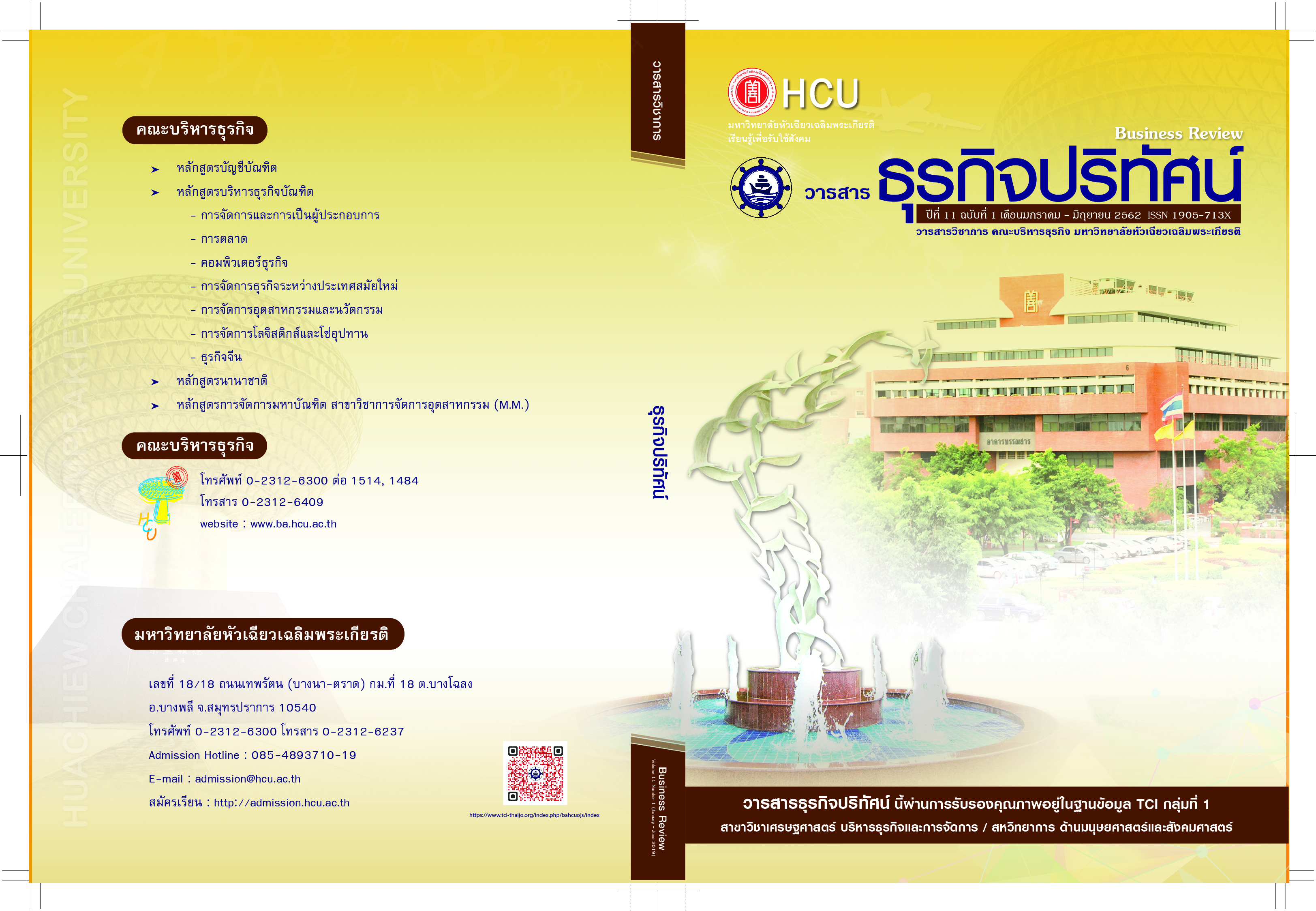Cultural Dimensions of Chinese that Affect to the Service Quality Expectations of Thai Restaurants
Keywords:
Cultural Dimensions, Service Quality Expectations, Thai Restaurants, Chinese CustomersAbstract
This research focused on (1) studying culture factors of Chinese customers affecting
to service quality expectations of Thai restaurants (2) Finding recommendations of service
quality development of Thai restaurants to implement in China. The research combined
both quantitative and qualitative methodologies. Quantitative research was used by distribute
questionnaires to 300 Chinese customers and quantitative research was in-depth interview with
2 Chinese customers. Accidental sampling was used, and data analysis statistics were frequency,
percentage, mean, standard deviation and multiple regression analysis. The research found
that the cultural dimension of Chinese customers gave the highest priority was masculinity/
Femininity (MAS). In terms of service quality expectations, the Chinese customers had the
highest perceived was reliability. The results of the Hypothesis testing showed that Chinese
customers perceived that the MAS, Uncertainty Avoidance Index (UAI) and Long-term
Orientation Index (LTO) dimensions were the variables that influence service quality
expectations.
References
พิมพ์ครั้งที่ 3. กรุงเทพฯ : โรงพิมพ์จุฬาลงกรณ์มหาวิทยาลัย.
ฐานเศรษฐกิจ. (2558). อาหารไทยเป็นที่ยอมรับระดับนานาชาติ...โอกาสธุรกิจที่เกี่ยวเนื่องในซัพพลายเชน.
สืบค้นเมื่อ 5 เมษายน 2561, จาก ฐานเศรษฐกิจ เว็ปไซต์: http://www.thansettakij.com/
content/106250.
Hair, J.F., Black, W.C., Babin, B.J., Anderso, R.E., and Tatham, R.L. (2006). Multivariate Data
Analysis. 6th Ed. New Jersey: Prentice Hall.
Hofstede, G., & Hofstede, G.J. (2005). Cultures and organizations: Software of the mind. Revised
and expanded. 2nd ed. New York: McGraw-Hill.
Hofstede, G. (1984). Culture’s consequences: international differences in work-related Values. (Abridged
ed.). Beverly Hills, CA: Sage Publications.
Markovic, S., Raspor, S., & Dorcic, J. (2011). What are the key dimensions of an empirical study
in the city restaurant settings. Sustainable Tourism, Socio-Cultural Environmental and
Economics Impact. 235-249.
Parasuraman, A., Zheitmal, V.A., and Berry, L.L. (1998). SERVQUAL: a multiple item scale for
measuring consumer perceptions of service quality. Journal of Retailing. 64(1), 12-40.
Parasuraman, A., Zeithaml V. A., and Berry, L. L. (1985). A conceptual model of service quality
and its implications for future research. Journal of Marketing, 49, 41-50.
Parasuraman, A., Zeithaml V. A., and Berry, L. L. (1990). Delivering service quality: balancing
Customers’ perceptions and expectations, New York: The Free Press.
The Ninh Nguyen, Tuan Khanh Cao, & Thi Thu Hoai Phan. (2015). Cultural Influences on Overall
Service Quality Expectations: Evidence from Vietnamese Customers. Asian Social
Science, 11(25),151-159.
Kueh, K., and Voon, B.H. (2007). Culture and service quality expectations: Evidence from Generation
Y consumers in Malaysia. Managing Service Quality: An International Journal, 17(6),
656-680.
Wang,Y, Vela, M.R., & Tyler, K. (2008). Cultural perspectives: Chinese perceptions of UK hotel
service quality. International Journal of Culture, Tourism and Hospitality Research, 2(4),
312-329.
Downloads
Published
How to Cite
Issue
Section
License
All articles published in the Business Administration and Management Journal Review are copyrighted by the journal.
The views and opinions expressed in each article are solely those of the individual authors and do not represent those of Huachiew Chalermprakiet University or any other faculty members. Each author is fully responsible for the content of their own article. Any errors or issues found are the sole responsibility of the respective author.




